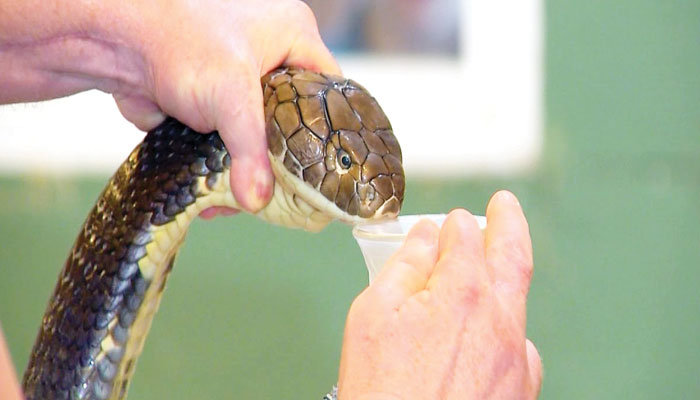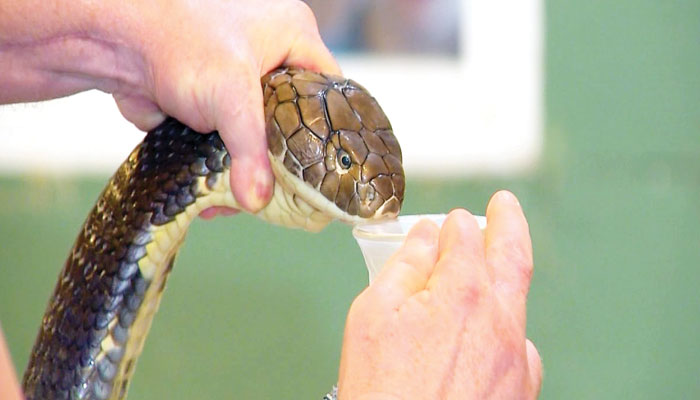
Venomous snakes that are geographically of the same genus and species differ in the level of components in their venom. This is mainly due to the fact that the venom of different species of snakes naturally contains different types of toxins, such as cobras or kraits, which belong to the family of venomous snakes in general, have toxins that affect the nervous system. While vipers affect the blood and circulatory system. This is a huge and obvious difference that comes from being of different race and family.
It should be discussed if the snakes of the same species or the same species are spread over a wide area in different geographical conditions, such as the cobra snake, which is spread from Asian countries to Africa and in different parts of these two continents. Contains types. In India, three types of cobra snake species are found in India and in Pakistan as well.
Being so widely distributed, the incidence of snake bites is high. This is the reason why this type of cobra venom has been extensively researched and there are numerous research papers. In the light of these studies, it has been revealed that even within the same species of snake, due to living in different regions, there may be differences in the composition of the venom. .
A research study published in an international journal in 2021 indicates this. In this study, cobra species Naja Naja Kazhar were collected from six different regions of India and analyzed genetically, physiologically, biologically, chemically and pharmacologically. The information obtained showed that even within the same species of cobra, there was significant variation in venom, which was termed biogeographical venom variation.
The study also observed that the venom of cobras in the western part of the country is more dangerous than that of cobras in the eastern part. It was also found that the venom of a cobra found in or around urban areas is more lethal than that of a cobra in rural areas. Due to similar geographical variation, viper venoms have been biased despite being the same species of snake.
There are many species of viper snakes in South America as well. There are also several species of snakes belonging to the cobra family. The venoms of two different snake families, the pit viper and the coral snake, have also been studied for variation due to habitat variation. The result is more or less that there is a small or large difference in the components of the venom, even if it is the same species of snake. Tests on the venom of mamba snakes and puff adder snakes found in Africa also show the same.
These studies highlight the wide nature of geographic variation in snake venom and the importance of this variation for understanding snake ecology and evolution, as well as for developing effective antidotes to treat snakebite victims. This means that understanding the geographic variation of snake envenomation can be very important in developing effective snakebite prevention and treatment programs, especially in areas where venomous snakes are commonly found. Chief among these is that by analyzing the composition of snake venoms in a particular region, researchers can identify specific toxins and develop effective antidotes that are tailored to the snake venoms found in that region.
This information can be highlighted in public education and awareness programs. This may include information on how to avoid snakes, what to do in the event of a snake bite, and how to identify different types of venomous snakes. It may also be possible to develop specialized venom detection kits using information on this geographical variation of snake venoms. These kits help medical personnel to quickly identify the type of snake and then, once it is identified which snake has bitten the patient, treat the patient using the antidote for that snake’s venom. In emergency situations like floods etc. such information can be very useful in these areas. Where the fear of snake bite is common.
Why this difference in venom exists when the type of snake is the same, we get the answer from the environment around the snake. Poison is a biological substance that has come into being through various evolutionary stages. Therefore, this liquid has the ability to change itself according to the environment. However, it is certain that such a change requires a long period of time, which may be at least more than a hundred years. During this time, diet, environmental and genetic changes gradually emerge and the snake’s venom begins to differ. It has been observed that the factor that makes the biggest difference is actually diet.
Snakes generally feed on small animals such as mice, lizards, reptiles and other small snakes. Snake venom is used to hunt and eat these animals. Lizards, frogs, and small reptiles are susceptible to snake venom, but animals such as mice and squirrels are resistant to snake venom.
Therefore, this difference can change the venom of the same species of snake living in urban areas and rural areas at the component level, where the snake needs a more lethal venom for its resistant prey, and on the other hand, in rural areas it does not. , as there is a greater variety of prey available and hunted more comfortably. The difference is observed in poisoning resulting from such a dose.
It occurs at the level of the toxin where components of the nervous system, blood system and cell damage are altered. In addition, changes in the enzymes present in the venom were also observed, such as a decrease or excess of phospholipase enzymes or a specific type of phospholipase enzyme present in a venom compared to the same type of snake venom found in other regions. don’t be Most of the research done in our country is based on the difference between the venom of snakes found in Pakistan and other countries. Where the venoms of the same species of snakes in India, Sri Lanka and other neighboring countries have been studied to compare with each other.
For example, the Russell’s viper and the Indian crate snake, which are found in other countries in the subcontinent, including Pakistan, have been the subject of such studies. As a region, Pakistan consists of deserts, rivers, mountains and plains in its latitude, which give birth to different ecosystems. Keeping this observation in mind, here we also have a type of snake which is found in all regions of the country, can be a subject candidate for research study. One such research study was carried out at the Proteomics Center, University of Karachi. There are several species of venomous snakes in Pakistan, which are found in all four provinces or at least three provinces. The four provinces of Pakistan are geographically distinct from each other.
Therefore, it is understandable that the venom of the same type of snake will vary greatly due to the environment of the provinces. Three venomous snakes, Russell’s Viper, Sa-scale Viper and Cobra are found in all four provinces of Pakistan. Among them, this study was initiated on cobra snake venom. The results showed that the cobra, Najanaja, present in Pakistan has regional differences in its venom. This observation suggests that an antidote should be developed for the venom of the cobra snake found in Pakistan. A collection of cobra venoms from all provinces should be used in this. In this way, cobra bite patients can get better treatment and effective facilities can be provided to the local population.
The same principle can be applied to other species of venomous snakes. It is also important to mention here that climate change has been affecting the world for the last ten years, which is not only affecting the human population, but the habitats of the organisms living in different regions of the world are also being affected by it. . Thus, the migration of animals due to habitat change and the adoption of new ways to settle in new areas is actually changing their physiological systems.
This change is most easily understood in the study of snake venom. Therefore, the evolutionary adaptation of different traits and the process of procreation while surviving can be studied through geographical influences on snake venom. The law of survival of the fittest was given centuries ago by Darwin. It is still active today to advance the life in the world. The more the organism adapts to the changing environment of the world, the more successful the generation will be on this planet.
setTimeout(function(){
!function(f,b,e,v,n,t,s)
{if(f.fbq)return;n=f.fbq=function(){n.callMethod?
n.callMethod.apply(n,arguments):n.queue.push(arguments)};
if(!f._fbq)f._fbq=n;n.push=n;n.loaded=!0;n.version=’2.0′;
n.queue=[];t=b.createElement(e);t.async=!0;
t.src=v;s=b.getElementsByTagName(e)[0];
s.parentNode.insertBefore(t,s)}(window,document,’script’,
‘https://connect.facebook.net/en_US/fbevents.js’);
fbq(‘init’, ‘836181349842357’);
fbq(‘track’, ‘PageView’);
}, 6000);
/*setTimeout(function(){
(function (d, s, id) {
var js, fjs = d.getElementsByTagName(s)[0];
if (d.getElementById(id)) return;
js = d.createElement(s);
js.id = id;
js.src = “//connect.facebook.net/en_US/sdk.js#xfbml=1&version=v2.11&appId=580305968816694”;
fjs.parentNode.insertBefore(js, fjs);
}(document, ‘script’, ‘facebook-jssdk’));
}, 4000);*/



